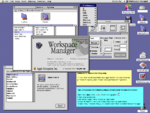Mac OS X: Difference between revisions
imported>Alex Bravo No edit summary |
imported>Paul Derry No edit summary |
||
| Line 29: | Line 29: | ||
|} | |} | ||
'''Mac OS X''' is a proprietary, [[Unix]]-like [[operating system]] developed, marketed, and sold by [[Apple Inc.]], which currently ships on all Macintosh computers. It succeeds the original [[Mac OS]] with its [[Aqua (user interface)|Aqua]] [[graphical user interface]] and [[Cocoa (API)|Cocoa]] [[API]], based on technologies of the | '''Mac OS X''' is a proprietary, [[Unix]]-like [[operating system]] developed, marketed, and sold by [[Apple Inc.]], which currently ships on all Macintosh computers. It succeeds the original [[Mac OS]] with its [[Aqua (user interface)|Aqua]] [[graphical user interface]] and [[Cocoa (API)|Cocoa]] [[API]], based on technologies of the defunct [[OPENSTEP]] operating system from [[NeXT]], absorbed with Apple's purchase in late 1996.<ref>{{ cite web | last = Singh | first = Amit | title = A Brief History of Mac OS X | url = http://www.kernelthread.com/mac/osx/history.html | work = What is Mac OS X? | date = 2004-01-07 }}</ref> The operating system was first released in 1999 in the form Mac OS X Server 1.0, with a desktop-oriented version following in March 2001. Mac OS X has ever since become the most used and probably most popular Unix in the world. Its [[open source]] core, named [[Darwin (operating system)|Darwin]], is based on [[FreeBSD]] and the [[Mach]] [[microkernel]] and integrates many open source software.<ref>{{ cite web | last = Singh | first = Amit | title = Architecture of Mac OS X | url = http://www.kernelthread.com/mac/osx/arch.html | work = What is Mac OS X? | date = 2004-01-07 }}</ref> It is freely supplied with every Macintosh. | ||
==History== | ==History== | ||
Revision as of 15:07, 10 April 2007
| Mac OS X |
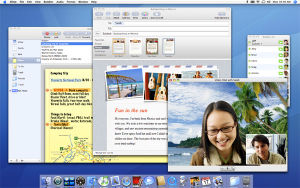
|
| Screenshot of the developer preview of Mac OS X v10.5 |
| Website: http://www.apple.com/macosx/ |
| Developer: Apple Inc. |
| OS family: BSD/Darwin/NEXTSTEP |
| Source model: Closed source (with open source components) |
| Latest stable release: 10.4.9 / March 13, 2007 |
| Supported platforms: x86, x86-64, PowerPC (32 & 64-bit) |
| Kernel type: Hybrid kernel (XNU) |
| Default user interface: Graphical user interface (Aqua) |
| License: proprietary |
| Working state: Current |
Mac OS X is a proprietary, Unix-like operating system developed, marketed, and sold by Apple Inc., which currently ships on all Macintosh computers. It succeeds the original Mac OS with its Aqua graphical user interface and Cocoa API, based on technologies of the defunct OPENSTEP operating system from NeXT, absorbed with Apple's purchase in late 1996.[1] The operating system was first released in 1999 in the form Mac OS X Server 1.0, with a desktop-oriented version following in March 2001. Mac OS X has ever since become the most used and probably most popular Unix in the world. Its open source core, named Darwin, is based on FreeBSD and the Mach microkernel and integrates many open source software.[2] It is freely supplied with every Macintosh.
History
Following the limited success of Apple attempts to modernize its Mac OS (the Copland Project), the company decided to use existing technology for the tenth version of its operating system. While Be Inc seemed to be the most appropriate candidate, NeXT's technologies were chosen as the basis for Apple's new operating system. Rhapsody, code name for the system, joined the Mach microkernel, a BSD operating system layer, the Yellow Box object-oriented frameworks from OPENSTEP and the Blue Box environment for backwards-compatibility with the classic Mac OS. Rhapsody evolved into Mac OS X Server 1.0[3], the predecessor to Mac OS X, as it did not ship with the Aqua user interface, which is one of the most notable new features of OS X.
While backwards-compatibility was a major point in the first release of the operating system, each new version of Mac OS X has evolved away from it, with the transition to Intel processors making Apple finally discard the Classic mode, included in versions for the PowerPC.
Mac OS X has seen 5 releases as of early 2007. Mac OS X v10.0 was the first release, and Mac OS X v10.4.9 is the most recent, with a projected release of the next major iteration —Mac OS X v10.5 "Leopard"— sometime in spring 2007.
Description
Mac OS X is a radical departure from previous Macintosh operating systems, its underlying code base being completely different from previous versions. Unlike its predecessors, Mac OS X is a Unix-like operating system and includes standard Unix utilities, available from the command line interface. Darwin, the core of the operating system, is built on top of the hybrid kernel XNU, which is a combination of the Mach 3 microkernel, various elements of FreeBSD 5 like the process model, network stack, and virtual file system and an object-oriented device driver API called I/O Kit. Apple layered over Darwin a number of proprietary components, most notably the Quartz graphics layer and the Aqua interface, to complete the GUI-based operating system which is Mac OS X. It includes Apple's free software development tools, most notably Apple's integrated development environment named XCode, which supports programming languages such as C, C++, Objective-C, and Java.
Mac OS X includes a number of features intended to make the operating system more stable and reliable than Apple's previous operating systems. Pre-emptive multitasking and memory protection, for example, improved the ability of the operating system to run multiple applications simultaneously without them interrupting or corrupting each other. Many aspects of Mac OS X's architecture are derived from OPENSTEP, which was designed with portability in mind, thus easing the transition from one platform to another. NEXTSTEP was ported from the original 68k-based NeXT workstations to other architectures before NeXT was purchased by Apple, and OPENSTEP was subsequently ported to the PowerPC architecture as part of the Rhapsody project. Thus, Mac OS X is able to run on multiple platforms. While the first 4 releases only were only sold for the PowerPC processors, Mac OS X has had builds running on the x86 and x86-64 processors since its conception. The x86 version of the operating system has become mainstream since Apple's transition to Intel, which started with version 10.4. The iPhone version of OS X is also supposed to able to run on at least one form of ARM processor.
Versions
| Retail box | Version | Code name* | Release date | New features |
|---|---|---|---|---|
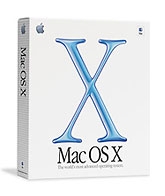 |
10.0 | Cheetah | March 24, 2001 |
|
 |
10.1 | Puma | September 25, 2001 |
|
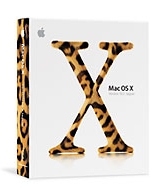 |
10.2 | Jaguar | August 24, 2002 |
|
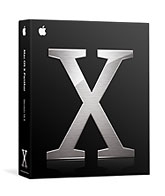 |
10.3 | Panther | October 24, 2003 |
|
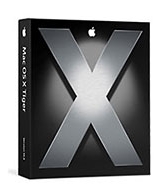 |
10.4 | Tiger | April 29, 2005 |
|
| No image yet | 10.5 | Leopard | Spring 2007 |
|
* From version 10.2 onwards, code names were employed for branding.
References
- ↑ Singh, Amit (2004-01-07). A Brief History of Mac OS X. What is Mac OS X?.
- ↑ Singh, Amit (2004-01-07). Architecture of Mac OS X. What is Mac OS X?.
- ↑ Anguish, Scott (1998-07-09). Apple Renames Rhapsody, now Mac OS X Server.
- ↑ Mac OS X “Gold Master” Released To Manufacturing (2001-03-07).
- ↑ Apple Previews Next Version of Mac OS X (2001-07-18).
- ↑ Apple Introduces “Jaguar,” the Next Major Release of Mac OS X (2002-07-17).
- ↑ Apple Announces Mac OS X “Panther” (2003-10-24).
- ↑ Apple to Ship Mac OS X “Tiger” on April 29 (2005-04-12).
- ↑ Apple Previews Mac OS X Leopard (2006-08-07).
External links
- Mac OS X - The official Apple web page for the Mac OS X operating system
- Apple Developer Connection - Resources for Mac OS X developers
